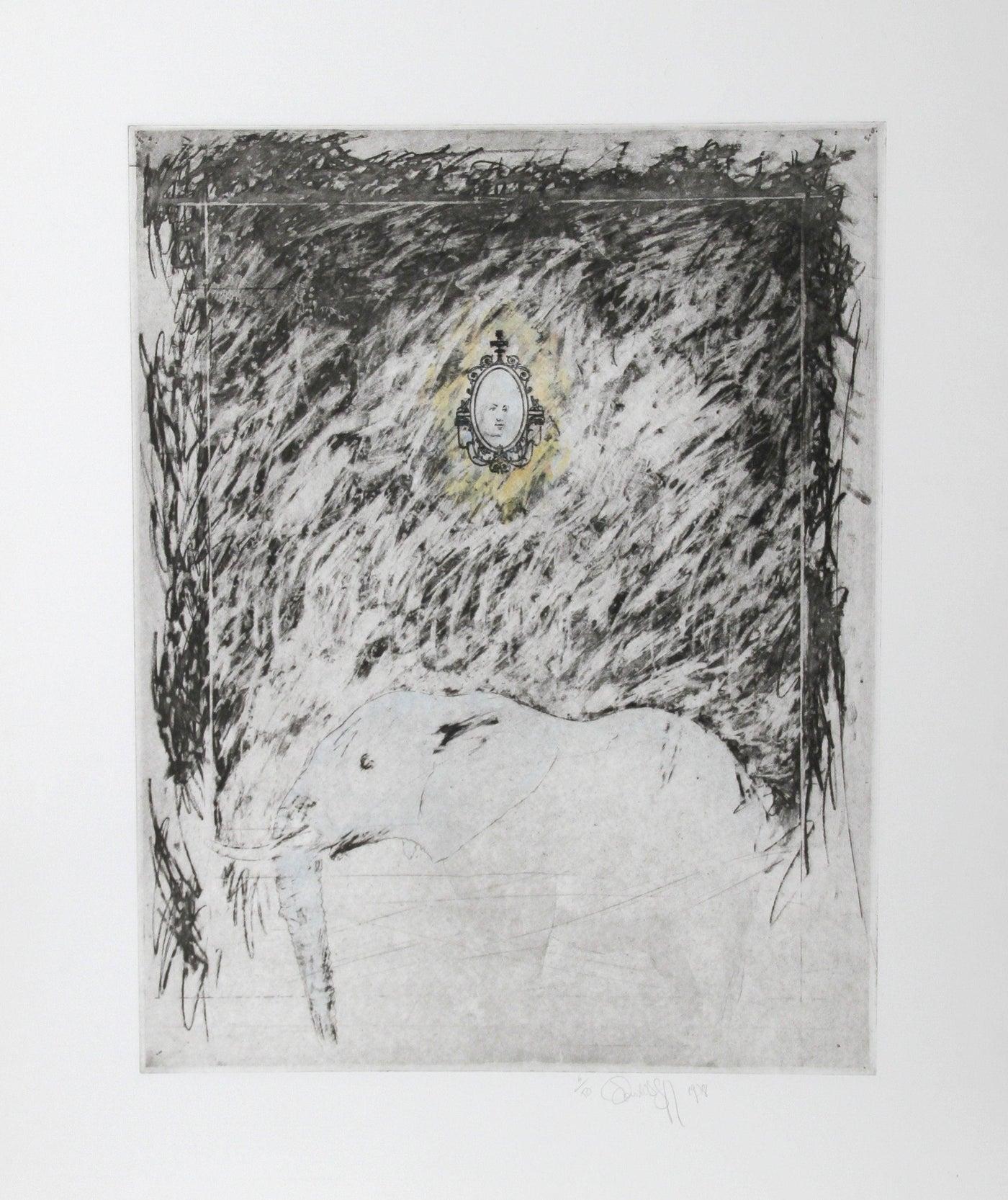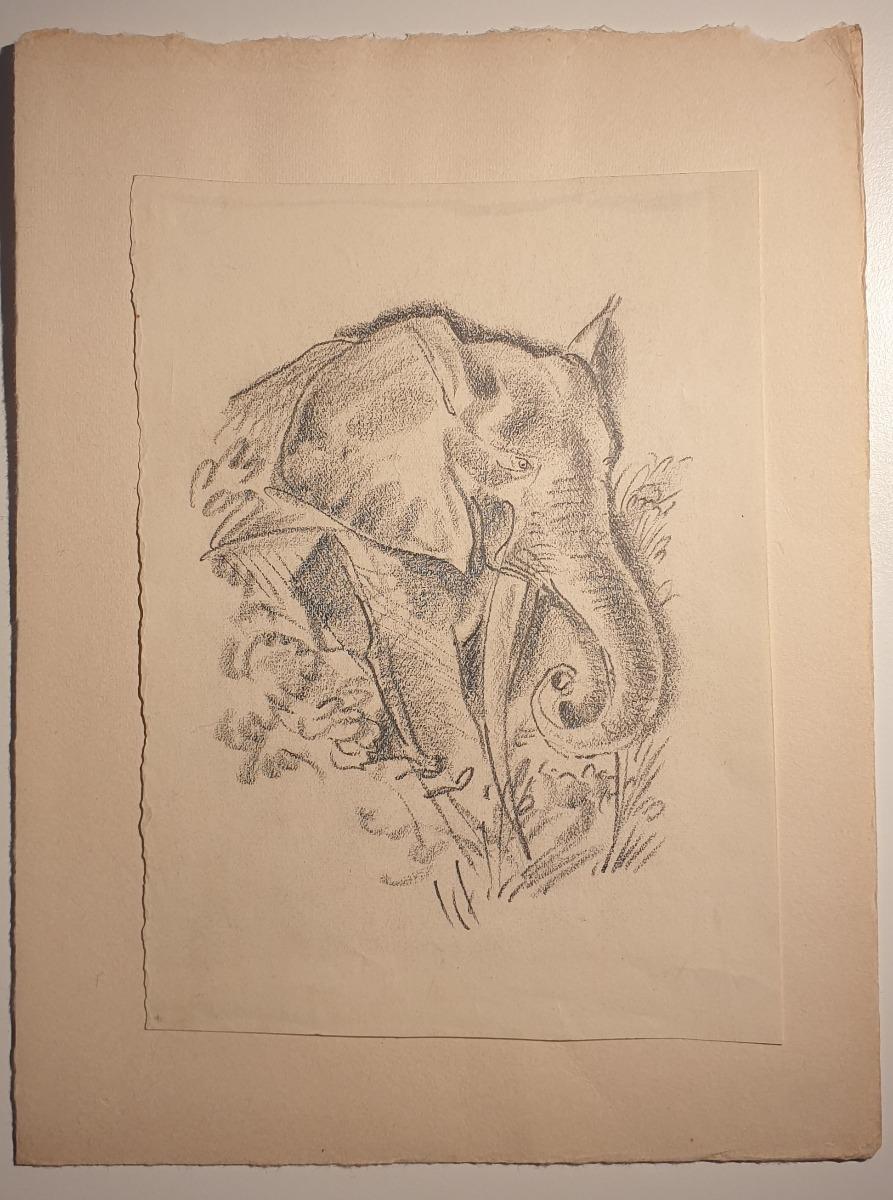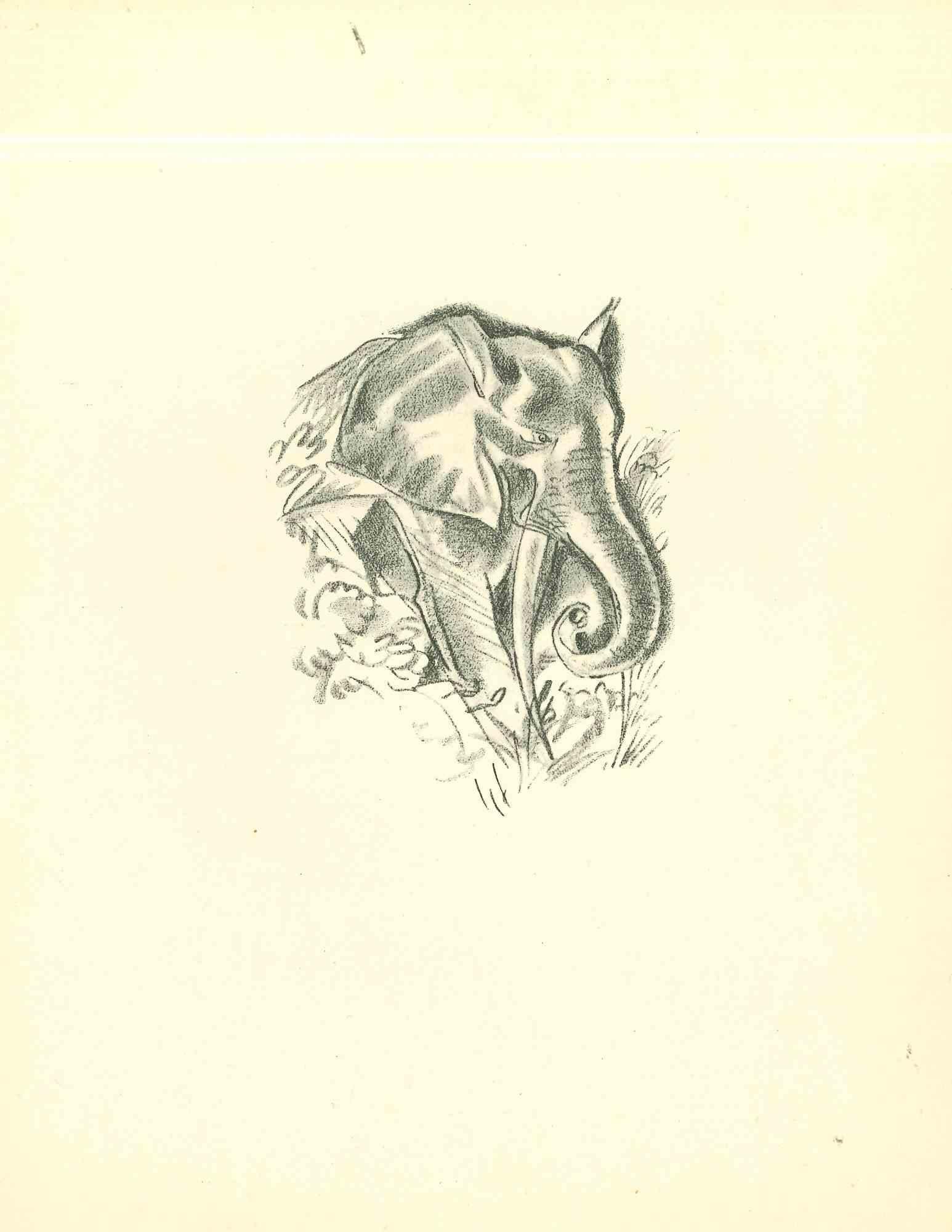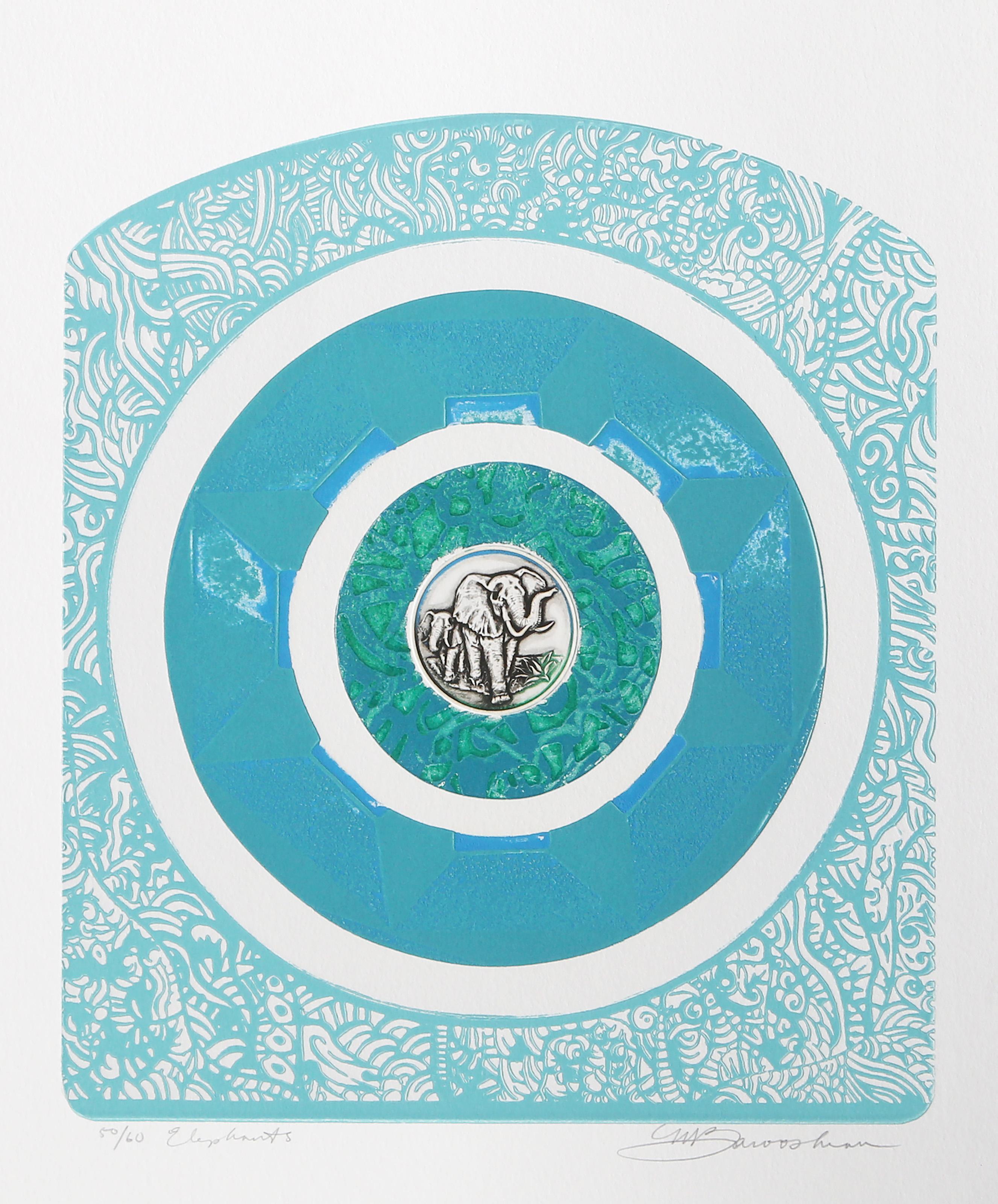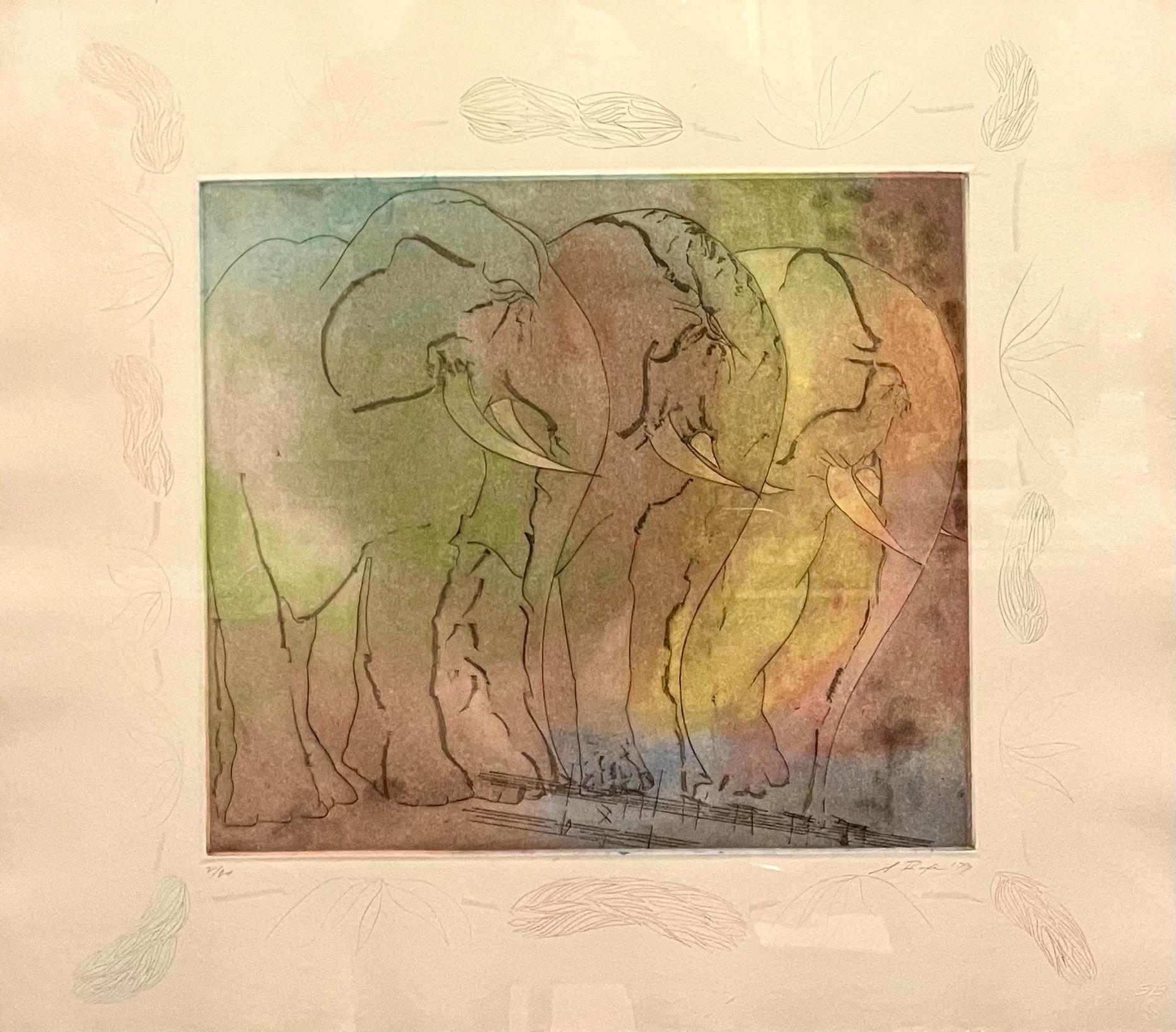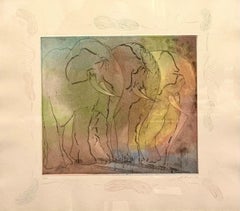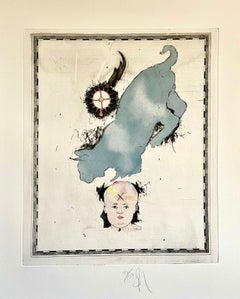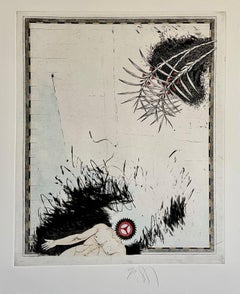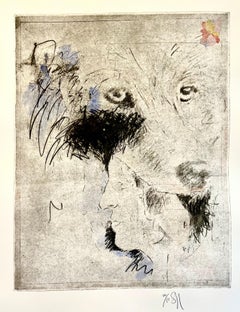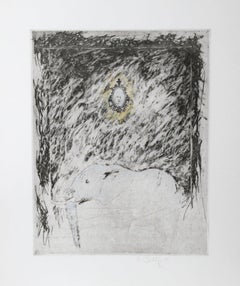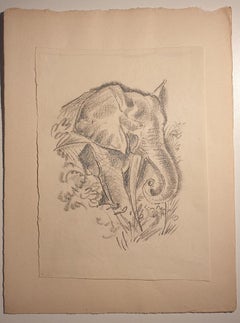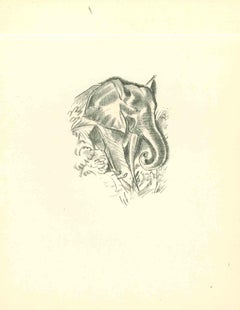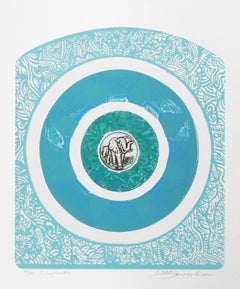Items Similar to Large Donald Saff Surrealist Pop Art Aquatint Etching African Elephant
Want more images or videos?
Request additional images or videos from the seller
1 of 11
Donald SaffLarge Donald Saff Surrealist Pop Art Aquatint Etching African Elephantc.1980
c.1980
$900
£700.71
€796.91
CA$1,294.88
A$1,422.37
CHF 743.34
MX$16,962.99
NOK 9,412.71
SEK 8,768.74
DKK 5,954.88
About the Item
Artist: Donald Saff
Medium: Etching with Aquatint, Hand signed and numbered in pencil.
Donald Jay Saff (born 12 December 1937) is an artist, art historian, educator, and lecturer, specializing in the fields of contemporary art in addition to American and English horology. Saff was born in Brooklyn, New York.
Donald Saff began his undergraduate degree at Queens College, City University of New York, in 1955, initially envisioning a career as an electrical engineer. However, the following year Saff changed his major to art and learned printmaking, to graduate with a B.A. in 1959 and a M.A. in art history from Columbia University in 1960. In the years following, Saff was awarded a M.F.A. from Pratt Institute in 1962 and an Ed.D. in studio art and art history from Columbia University in 1964. In his early career, Saff studied with Robert Goldwater, Robert Branner, Louis Hechenbleikner, and Meyer Schapiro.
Saff is primarily known for his work and collaboration with the leading artists of the late-twentieth century, including Robert Rauschenberg, Jim Dine, Roy Lichtenstein, James Rosenquist, Nancy Graves, Philip Pearlstein, and James Turrell. Saff's prolific career is the subject of Marilyn S. Kushner's book, Donald Saff: Art in Collaboration (2010). Saff began his teaching career at Queens College as a lecturer in Art History, Design, and Drawing, from 1961 to 1964. In 1965, Saff was appointed as an associate professor in the visual arts department of the University of South Florida in Tampa, Florida, and became professor and chairman of the visual arts department two years later. In 1971, Saff became the founding dean of the College of Fine Arts at U.S.F., and was awarded the rank of distinguished professor at the university in 1982. Saff was later named dean emeritus by USF in 1989, and distinguished professor emeritus in 1996. In 1999, Saff was awarded the honorary degree of Doctor of Fine Arts at U.S.F. He was appointed the Director of Capital Projects of the Solomon R. Guggenheim Foundation, New York, in 2001, followed by the appointment of Senior Curator of Prints and Drawings in 2002.
In 1968, Saff founded Graphicstudio at U.S.F. through funding by a seed grant from the Florida Arts Council and community supporters; the following year, Philip Pearlstein was the first artist invited to Graphicstudio to collaborate with Saff and his team. Saff became Founding Dean of the College of Fine Arts at U.S.F. in 1971. Under Saff's directorship, Graphicstudio collaborated with artists such as James Rosenquist, Robert Rauschenberg, Richard Anuszkiewicz, Shusaku Arakawa, Jim Dine, Lee Friedlander, Nancy Graves, Ed Ruscha, and Roy Lichtenstein. The collection of Graphicstudio is archived in the National Gallery of Art in Washington, D.C.
Graphicstudio was founded by Dr. Donald Saff as part of the renaissance in American printmaking in the 1960s, in the company of studios such as ULAE, Tamarind, and Gemini GEL. This renaissance brought artists involved in the Pop art movement, such as Robert Rauschenberg, James Rosenquist, and Jim Dine, together with a growing number of trained printmakers from around the world. After Saff retired from U.S.F., he continued to collaborate with these artists, as well as James Turrell, at Saff Tech Arts in Oxford, Maryland, which was established in 1991.
While Saff and Rauschenberg were traveling in China, Rauschenberg conceived of the Rauschenberg Overseas Culture Interchange (ROCI) in 1982, which began in 1984 with Saff as the artistic director. Saff travelled to over twenty countries and met with poets and writers in order to decide which were the most appropriate venues for the show and prepare for Rauschenberg's visit and exhibition.
In recent years, Saff has continued to lecture and write on art and the history and mechanics of nineteenth-century clocks; in particular, the work of Charles Fasoldt, in addition to the development of time distribution from the Harvard College Observatory, and the horological innovations of Richard F. Bond. He has lectured on Fasoldt for the Antiquarian Horological Association in Cincinnati, OH (2001), the National Association of Watch and Clock Collectors in Pittsburgh, PA, and Anheim, CA (2003), and at the 26th Annual Ward Francillon Time Symposium in Houston, TX (2004), among other venues. Saff continues to work with the Royal Observatory in Greenwich, collaborating with Jonathan Betts and Rory McEvoy, on the trials of Burgess Clock B. (See "Honors.")
Exhibitions
Saff's individual work spans across his career of collaborative art. As early as 1965, Saff produced Duino Elegies, a print suite that was published and exhibited by Martin Gordon Gallery in New York and at the Galleria Academia in Rome; it was acquired by the Library of Congress, the Brooklyn Museum, and Lessing Rosenwald. Saff also collaborated with printers Galli and Arduini in Urbino to create print suites Breezes (1969), exhibited and published by the Martin Gordon Gallery. Additionally, Saff collaborated with Galli on print suites Paradise Lost (1970) and Numbers (1972), the former printed in Tampa, FL, and exhibited at the Martin Gordon Gallery, the University of South Florida Gallery, the Toronto Art Gallery, and the Loch Haven Art Center, FL. Numbers was exhibited at Multiples Gallery, New York. In 1979, Saff produced print suite Fables that was published and exhibited by the Getler/Pall Gallery in New York, followed by the print suite Constellations (1980), which was also exhibited at the Tom Lutrell Gallery in San Francisco. In 1981, Saff had solo exhibitions of his artwork in the Galleria d'Arte Moderna in Udine, Italy, Youngstown State University, OH, the Leo Castelli Gallery, NY, and in "Recent Acquisitions" at The Museum of Modern Art, NY. Additionally, Saff had solo exhibitions at Dyansen Gallery, NY (1982), at I. Feldman Gallery, Sarasota (1983), and at Edison Community College, FL (1988). In 1989, the retrospective Donald Saff: Mixed Metaphors, 1956–1989 was held at the Tampa Museum of Art and traveled to the Virginia Beach Center for the Arts, followed by his solo exhibition Winged Metaphors: Sculpture and Prints by Donald Saff at the Barbara Gillman Gallery in Miami later that year. In 1997, Brenau University Galleries exhibits Poetics: The Work of Donald Saff in Gainesville, GA. The same year, the Tampa Museum of Art exhibited Donald Saff/Robert Rauschenberg: In Collaboration. Finally, the Academy Art Museum in Easton, MD, exhibited Donald Saff: Gravity and Constellations; Selected Works in 2006.
Honors
Saff was awarded a Teaching Fellowship at Queens College (1960), a Yaddo Fellowship, Saratoga Springs, NY (1963), and Fulbright Fellowship (1964) to Italy where he studied at Istituto Statale di Belle Arti. While in Urbino, Saff met lifelong friend and colleague Deli Sacilotto, with whom he would co-author Printmaking: History and Process (1978) and Screenprinting: History and Process (1979). He received the Governor's Award for the Arts from the State of Florida in 1973, and was awarded the Florida Endowment for the Arts Individual Artist Grant in 1980. In 1997, Saff was awarded the title "Printmaker Emeritus" by the 25th Southern Graphics Council Conference in Tampa, F.L. In 2002, he was appointed as Visiting Distinguished Professor of Rhode Island School of Design.
In April 2015, Saff was awarded a certificate from the Guinness World Records for his work on completing the world's most accurate pendulum clock, "Clock B", which was started by Martin Burgess in 1975. The official title awarded by Guinness World Records, as "the most accurate mechanical clock with a pendulum swinging in free air is 'Clock B,' owned by Donald Saff (U.S.A.)" was presented on April 16, 2015, following the clock's 100-day trial at the Royal Observatory, Greenwich
- Creator:Donald Saff (1937, American)
- Creation Year:c.1980
- Dimensions:Height: 30 in (76.2 cm)Width: 22 in (55.88 cm)
- Medium:
- Movement & Style:
- Period:
- Condition:good. never framed.
- Gallery Location:Surfside, FL
- Reference Number:1stDibs: LU38215961382
About the Seller
4.9
Platinum Seller
Premium sellers with a 4.7+ rating and 24-hour response times
Established in 1995
1stDibs seller since 2014
1,837 sales on 1stDibs
Typical response time: 1 hour
- ShippingRetrieving quote...Shipping from: Surfside, FL
- Return Policy
More From This Seller
View AllStanley Boxer Aquatint Intaglio Etching Elephant Herd Abstract Expressionist
By Stanley Boxer
Located in Surfside, FL
Elephants. 1979
edition 2/20
Hand signed and dated
Framed 24.5 X 28. Sheet 23 X 26
This is from a series of prints Boxer produced at Tyler Graphics between 1975 and 1979. Over thi...
Category
1970s Abstract Expressionist Animal Prints
Materials
Etching, Aquatint, Intaglio
Large Donald Saff Surrealist Pop Art Aquatint Etching Blue cat with Baby
By Donald Saff
Located in Surfside, FL
Artist: Donald Saff
Title:
Year: 1980
Medium: Etching with Aquatint, Hand signed and numbered in pencil
Edition: 150
30 in. x 22.5 in. (76.2 cm x 55.88 cm)
bears publishers blindst...
Category
1980s Pop Art Figurative Prints
Materials
Etching, Aquatint
Large Donald Saff Surrealist Pop Art Aquatint Etching Action Figure Gearhead
By Donald Saff
Located in Surfside, FL
Artist: Donald Saff
Title: Action Figure
Year: 1980
Medium: Etching with Aquatint, Hand signed and numbered in pencil
Edition: 150
30 in. x 22.5 in. (76.2 cm x 55.88 cm)
Donald Jay...
Category
1980s Pop Art Figurative Prints
Materials
Etching, Aquatint
Large Donald Saff Surrealist Pop Art Aquatint Etching Wolf, Man
By Donald Saff
Located in Surfside, FL
Artist: Donald Saff
Title: Wolf and Man
Year: 1980
Medium: Etching with Aquatint, Hand signed and numbered in pencil
Edition: 50
39 in. x 27.5 in.
Donald Jay Saff (born 12 Decemb...
Category
1980s Pop Art Figurative Prints
Materials
Etching, Aquatint
Spanish Artist Santi Moix Aquatint Etching Ed 2/3 Surrealist Abstract Symbols
By Santi Moix
Located in Surfside, FL
Moix, Santi (Spanish, b. 1960), Figural Abstraction, hybrid print with etching and aquatint, 23.5 x 16.75 inches, pencil signed and numbered 2/3.
Santi Moix (Barcelona, 1960) lives ...
Category
20th Century Surrealist Abstract Prints
Materials
Etching, Aquatint
American Abstract Expressionist Artist Melissa Meyer Aquatint Etching
By Melissa Meyer
Located in Surfside, FL
Melissa Meyer (American, b. 1946)
1984-1987, aquatint etching in black on wove paper, hand signed print, dated, and numbered from small edition of 10.
Unframed. size: 9.75'' x 6'',...
Category
1980s Abstract Expressionist Prints and Multiples
Materials
Etching, Aquatint
You May Also Like
Elephant (Color), Etching by Donald Saff
By Donald Saff
Located in Long Island City, NY
Elephant (Color)
Donald Saff, American (1937)
Date: 1980
Aquatint Etching, signed and numbered in pencil
Edition of 50
Image Size: 24 x 18.5 inches
Size: 39 in. x 27.5 in. (99.06 cm ...
Category
1980s Conceptual Prints and Multiples
Materials
Etching, Aquatint
Africa - The Elephant - Original Lithograph by Emmanuel Gondouin - 1930s
Located in Roma, IT
Africa - The Elephant is an original artwork realized by Emmanuel Gondouin (Versailles, 1883 - Parigi, 1934) in 1930s.
Original Lithograph, part of a collection entitled "Africa".
...
Category
1930s Modern Figurative Prints
Materials
Paper, Lithograph
Elephant - Original Lithograph by Emmanuel Gondouin - 1930s
Located in Roma, IT
Elephant is an original lithograph realized in the early 1930s by Emmanuel Gondouin, (Versailles, 1883 - Parigi, 1934)
The artwork is depicted through strong strokes and is part of...
Category
1930s Modern Animal Prints
Materials
Lithograph
Elephants, Surrealist Etching and Aquatint by Martin Barooshian
By Martin Barooshian
Located in Long Island City, NY
Martin Barooshian, American (1929 - 2022) - Elephants, Year: circa 1979, Medium: Etching and Aquatint, signed, titled and numbered in pencil, Edition: 50/60, Image Size: 12 x 1...
Category
1970s Surrealist Animal Prints
Materials
Etching, Aquatint
Elephant Man, Dedicated Folk Art Aquatint Etching by Charles Bragg
By Charles Bragg
Located in Long Island City, NY
Artist: Charles Bragg, American (1931 - )
Title: Elephant Man
Medium: Etching with Aquatint, signed and dedicated to Bernie Madoff in pencil
Edition: 300...
Category
1970s Contemporary Figurative Prints
Materials
Etching, Aquatint
Klaus Zwick - "Lithography honours the Elephants" - colour lithograph
Located in Winterswijk, NL
Colour lithograph.
Year: 1993.
Hand-signed, numbered, and dated.
Edition: 1/1 - unique.
In good condition.
Some traces of glue on verso.
A beautiful artwork that looks good in ...
Category
20th Century Contemporary Prints and Multiples
Materials
Paper, Lithograph
$460 Sale Price
20% Off
